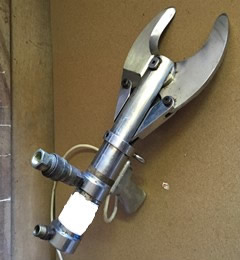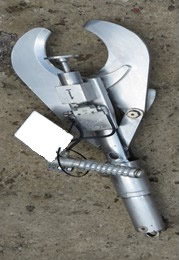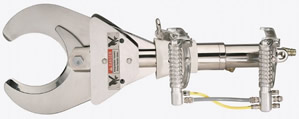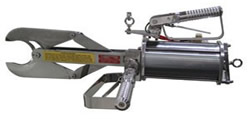Single hand operated hock cutters
Published: 21 September 2017
Purpose
The purpose of this safety alert is to highlight the risks associated with single hand operated hock cutters used in the meat processing industry.
Hock cutters are hydraulic or pneumatic (air) powered mechanical scissors used to cut off the limbs of carcasses during meat processing. These hand held units tend to have very sharp blades to ensure a clean cut and are capable of exerting extremely high forces to easily cut through bone.
Background
In June 2017, a worker was seriously injured while using a single hand operated hock cutter. While operating the hock cutter with his right hand, the worker's left hand inadvertently contacted the cutting blades during a cutting cycle. At the same time there was a sudden loss of hydraulic pressure in the system, resulting in the hock cutter being unable to complete the cutting cycle (i.e. the cutting jaws closing completely) and the worker's hand became trapped between the cutting jaws. His middle finger and part of the index finger were amputated.
 |  | |
| Photograph 1 and 2: Examples of single hand operated hock cutters. | ||
Contributing factors
There may be several reasons why this type of incident occurs, including one or more of the following factors:
- When using a single hand operated hock cutter, a worker's free hand is able to hold the carcass hock in close proximity to the cutting jaws. This significantly increases the risk of the worker's free hand inadvertently coming into contact with the cutting jaws during a cutting cycle.
- Older style hock cutters generally have limited or no ability to reverse sequence during a cutting cycle (i.e. the cutter jaws must go through a complete cutting cycle before the cutting jaws can open up). This makes it hard to release entrapped workers without the use of tools.
- Workers can sustain serious crush injuries if their free hand inadvertently contacts the cutting blades and there is a sudden loss of pressure in the system at the same time, trapping their hand between the cutting jaws.
Action required
Owners and users of single hand operated hock cutters should assess the ongoing safety of the current system. It may be necessary to redesign or select another device that eliminates or minimises the risk of workers inadvertently contacting the cutter blades with their free hand.
Recommended control measures
Contact manufacturers to discuss the availability of additional proprietary controls that could be fitted to existing single hand operated units which require both the operator's hands to be occupied.
Two-hand operated hock cutters
Two hand operated hock cutters have been available in the meat processing industry for a number of years. Modern designs include an activation system that requires the user to have both hands on the device to successfully activate it. Two hand operated hock cutters should be 'anti-tie down' so that the safety activation system cannot be easily circumvented to allow single hand operation. Anti-tie down requires the operator to depress both triggers simultaneously. Premature activation of either triggers will not activate the hock cutter. This greatly reduces the risk of the operator's hands from reaching the cutting blades.
 |  | |
| Photographs 3 and 4: Examples of two hand operated hock cutter | ||
Further information
Further information can be obtained from the following: